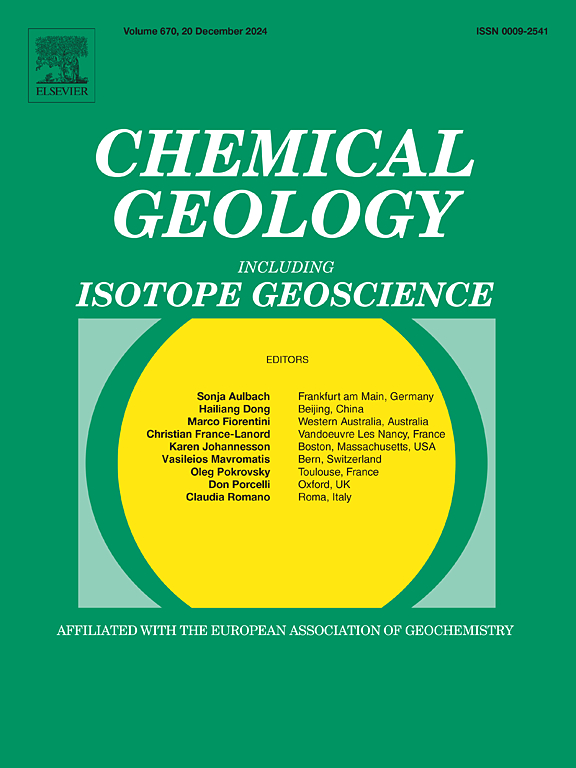The stable U-Mo-Fe isotope records of Middle Jurassic hydrogenetic ferromanganese deposits
IF 3.6
2区 地球科学
Q1 GEOCHEMISTRY & GEOPHYSICS
引用次数: 0
Abstract
Ferromanganese (Fe-Mn) nodules are marine chemical sediments that represent unique archives for the reconstruction of ambient seawater conditions. This record is limited from modern to Cenozoic times due to the instability of Fe-Mn oxides during burial and subduction of the oceanic crust and overlying sediments. However, almost uncharacterized Fe-Mn nodules exist in Jurassic sedimentary strata throughout the ancient Tethyan region approximately 100 Ma older than the oldest yet-investigated Cenozoic nodules. Their reliability as geochemical archives for the reconstruction of ancient seawater is, however, poorly understood. In this study, Fe-Mn nodules from the Pyhrntal area (Austria) are geochemically and mineralogically characterized and subdivided into four types with variable amounts of carbonates (calcite, rhodochrosite), todorokite, and hematite as major phases. Shale-normalized rare earth element and yttrium systematics of all types indicate a hydrogenetic origin with characteristic positive Ce anomalies and negative Y anomalies. In-situ Fe isotope measurements of the Fe-Mn nodules display a δ56/54Fe range between −0.32 and −0.02 ‰ for the Jurassic Tethyan Ocean, similar to values from modern Atlantic nodules. Stable Mo (δ98/95Mo = −0.97 to −0.56 ‰) and U (δ238/235U = −0.75 to −0.47 ‰) isotope compositions resemble those of modern and Cenozoic Fe-Mn nodules, suggesting that Middle Jurassic oceans were similarly well‑oxygenated as modern oceans. Our results demonstrate the reliability of fossil Fe-Mn nodules in the Pyhrntal as geochemical archives for the composition of paleo-seawater, encouraging the investigation of other ancient Fe-Mn deposits which may significantly improve and complement the picture of the redox evolution of Phanerozoic oceans.
中侏罗统氢成锰铁矿床U-Mo-Fe稳定同位素记录
锰铁(Fe-Mn)结核是海洋化学沉积物,代表了重建海水环境条件的独特档案。由于铁锰氧化物在海洋地壳和上覆沉积物的埋藏和俯冲过程中不稳定,这一记录从现代到新生代受到限制。然而,在整个古特提斯地区的侏罗纪沉积地层中,存在着几乎未被表征的铁锰结核,比迄今为止研究过的最古老的新生代结核早约100 Ma。然而,它们作为重建古代海水的地球化学档案的可靠性却鲜为人知。本研究对奥地利Pyhrntal地区的Fe-Mn结核进行了地球化学和矿物学表征,并将其划分为四种类型,主要相为不同数量的碳酸盐(方解石、菱锰矿)、云母岩和赤铁矿。各类型页岩归一化稀土元素和钇分系统均显示成氢成因,具有典型的正Ce异常和负Y异常。铁锰结核的原位铁同位素测量结果显示,侏罗纪特提斯洋的铁锰结核的δ56/54Fe值在- 0.32 ~ - 0.02‰之间,与现代大西洋结核的值相似。稳定的Mo (δ98/95Mo = - 0.97 ~ - 0.56‰)和U (δ238/235U = - 0.75 ~ - 0.47‰)同位素组成与现代和新生代铁锰结核相似,表明中侏罗世海洋与现代海洋相似。我们的研究结果证明了Pyhrntal中化石铁锰结核作为古海水组成的地球化学档案的可靠性,鼓励了对其他古代铁锰矿床的研究,这些矿床可能会显著改善和补充显生宙海洋氧化还原演化的图景。
本文章由计算机程序翻译,如有差异,请以英文原文为准。
求助全文
约1分钟内获得全文
求助全文
来源期刊

Chemical Geology
地学-地球化学与地球物理
CiteScore
7.20
自引率
10.30%
发文量
374
审稿时长
3.6 months
期刊介绍:
Chemical Geology is an international journal that publishes original research papers on isotopic and elemental geochemistry, geochronology and cosmochemistry.
The Journal focuses on chemical processes in igneous, metamorphic, and sedimentary petrology, low- and high-temperature aqueous solutions, biogeochemistry, the environment and cosmochemistry.
Papers that are field, experimentally, or computationally based are appropriate if they are of broad international interest. The Journal generally does not publish papers that are primarily of regional or local interest, or which are primarily focused on remediation and applied geochemistry.
The Journal also welcomes innovative papers dealing with significant analytical advances that are of wide interest in the community and extend significantly beyond the scope of what would be included in the methods section of a standard research paper.
 求助内容:
求助内容: 应助结果提醒方式:
应助结果提醒方式:


